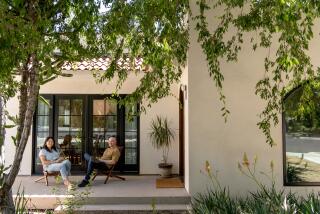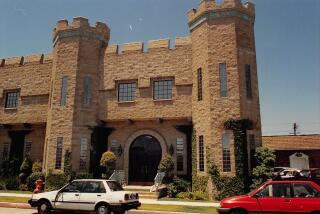This Magazine Is a Cottage Industry
- Share via
SIERRA MADRE — John Brinkmann, the bearded publisher of American Bungalow magazine, has what might be called “basic instinct.”
When he approached a marketing expert in early 1990 about launching a magazine solely dedicated to bungalow living, the consultant thought he was a crank.
Her reaction, Brinkmann recalls, was: “Bungalows? You mean those little, ugly buildings on school campuses where you go when you can’t get a regular classroom?”
Then Brinkmann sent a questionnaire to historical societies across the country, promising a free subscription to any that would critique his idea.
“Of the 200 or so we got back,” he says, “about 30% said, ‘Yeah, neat, I’m glad someone’s finally doing something for the bungalow. We’ve got hundreds of them, they’re wonderful little homes.’
“But the other 70% said: ‘Sure we have bungalows. So what! Who cares?’ ”
For the past two years, Brinkmann has sporadically put out a slick, approximately 48-page magazine devoted to answering that question. American Bungalow’s fourth issue, due out in June, will have a circulation of 5,000.
Currently, American Bungalow is distributed through subscriptions and art and museum-based bookstores. The magazine is still subsidized by his graphic arts business and by the goodwill of contributors, but he hopes it will soon make money.
When Brinkmann moved his studios from a tony, Norman-style office building in mid-Wilshire in 1987 to a spacious 1914 bungalow called Twycross House in Sierra Madre, he didn’t consider his new quarters unique.
“I wasn’t drawn to it because it was a Craftsman house,” he says. “They were so common that in my thinking they weren’t anything special.”
Because of the way his home would look from the air, with a center core and two wings, it’s known as an airplane bungalow. Like the classic California Craftsman, it’s part of the larger bungalow genre, which usually consist of relatively small houses of one story and an attic.
But as Brinkmann had difficulty finding authentic replacement parts for his bungalow--hexagonal, glass drawer pulls, for example--a light went on. Why not publish a fact sheet where homeowners, crafts people, designers and vendors could exchange information about bungalows?
The newsletter concept quickly gave way to a magazine format. “It became clear that to do it right we had to tell people where to go to find things,” Brinkmann said, “and that meant advertising and taking on ads. And once we did that we weren’t a newsletter anymore.”
Again, Brinkmann went seeking advice. “We talked to the experts,” he recalled, “and felt hopelessly underfunded because big magazines start up on millions of dollars, and we would be starting up on thousands.”
Then he attended his first Sierra Madre Historical Preservation meeting on a rainy might in March, 1990, and listened to Robert Winter, author of “The California Bungalow,” describe the simple, elemental charm of bungalows--their bright, airy rooms trimmed with dark wood, and decorated with American art pottery, heavy oak furniture and landscape paintings. The talk was held in a Craftsman bungalow whose fireplace housed boulders big enough to form benches.
“I was sitting on one of those,” Brinkmann said, “listening to the rain fall on the chimney and Dr. Winter sharing the magic of the bungalow lifestyle, and that really tipped me over the edge.”
But how could he market his magazine in the competitive, cutthroat world of publishing, in which magazines were folding faster than you could say recession?
Brinkmann devised a strategy to develop a high-quality product on a limited budget, cutting deals with top photographers and free-lance writers, who expressed more interest in the burgeoning arts and crafts movement than in immediate remuneration.
The writers and photographers get little or no pay now, on the hope that their efforts will make the magazine successful--and thus able to pay them.
Another part of Brinkmann’s plan was to publish quarterly, but that was only a goal. He didn’t want to get caught in a costly printing cycle that could bankrupt his enterprise before it got off the ground. For once, he didn’t seem to be breaking precedent.
“When we started out,” he said, “we learned there were lots of special-interest magazines that didn’t publish regularly. They even have a term for them, ‘zines.’ ”
About 10,000 copies of the first American Bungalow magazine were printed in time for the 1990 National Trust for Historic Preservation Conference in Asheville, N.C. Bruce Johnson, who organizes the annual Arts & Crafts Conference and Antique Show in Asheville, said the magazine was the buzz of the preservation conference.
“The big news was that we were opening up a whole new market for people in the restoration business,” Brinkmann said, “your chimney builders, wallpaper hangers, painters, tile men, etc.
“Preservationists who made their living restoring Victorians were saying, ‘Look, if they now have a magazine for bungalows, there must be real interest there.’ ”
Through the next three issues of American Bungalow, Brinkmann continued to rely on a loyal core of subscribers and advertisers to help him nourish his fledgling enterprise.
Richard Perris, manager of Crown City Hardware Co, a Pasadena institution since 1916, has advertised with American Bungalow since the beginning, despite its small circulation.
“We believe in them,” he said. “In fact, we developed the same way, slowly building a reputation for quality. Success doesn’t happen overnight.”
Albert Griffin, American Bungalow advertising director, said that when a major furniture company withdrew its advertising in the second issue, many of the magazine’s readers complained directly to the manufacturer. The company renewed its advertisement for the following issue.
Richard Ellison of Ellison & Co., a Pasadena advertising consulting firm that tracks lifestyle and home magazines like Metropolitan Home and Old House Journal, said American Bungalow can survive despite its shoestring funding.
“It’s definitely a very classy, niche-marketed magazine,” he said. As the magazine continues to micro-market (or closely target) its editorial product, it also needs to target customers and advertisers interested in the movement, Ellison said.
But Robert Schweitzer, an architectural historian and author of the book “America’s Favorite Homes,” says interest in American Bungalow may be broader.
“If you look at the era between the turn of the century and World War II,” Schweitzer said, “more houses were built in the United States than in the entire history of the country before that time, and many of those were bungalows.”
Often produced from $2,000 or $3,000 Sears, Roebuck & Co. or Montgomery Ward mail-order kits, bungalows sprang up in such diverse places as Jacksonville, Fla.; Ann Arbor, Mich., and Pasadena.
Frequently in or near city centers, bungalows also attract buyers concerned about the environment. Their owners generally spend less time on congested freeways and more time in downtown neighborhoods, revitalizing and reversing years of urban neglect. “For every house that they rehab, they are saving another from being built,” Schweitzer said.
He noted that two-bedroom, 1,300 to 1,400 square-foot bungalows in gentrified areas of major cities attract $700,000 purchase offers.
The bungalow look has set the stage for commercials, television sitcoms and talk shows, he said. Eager to increase sales, mass merchandisers and manufacturers such as Spiegel, Sherwin-Williams and Ethan Allen are selling exclusive bungalow lines of furniture and housewares.
“People are just enthralled with the architecture--the beams in the ceiling, the built-in furnishings, the overhanging eaves, the porches and the quietness of the layout,” Schweitzer said. “It’s a real personal style or aesthetic as opposed to the gaudy Victorian style.”
Despite its high-art, coffee-table appearance, American Bungalow serves as a useful and reassuring guide for the discriminating bungalow owner.
“I have used it to find suppliers of period paints and light fixtures for my bungalow,” said subscriber Virginia Wooldridge, a bookkeeper who with her animator husband, Thomas, works out of their home on Gramercy Place in Los Angeles.
“For me, it served as confirmation for some of the work my neighbors and I had already completed,” says Jennifer Charnofsky, a subscriber and teacher who lives in a large Craftsman in the West Adams section of Los Angeles. “It shows us a goal and lets us know we’re not isolated.”
Said Brinkmann: “Part of our mission is to inform people that there’s nothing magical about putting a bungalow back the way it was supposed to be.
“And generally the way it was supposed to be is pretty good by today’s standards.”


